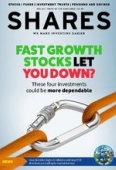Archived article
Please note that tax, investment, pension and ISA rules can change and the information and any views contained in this article may now be inaccurate.
How to find and analyse quality growth companies

This is part one of three articles looking at how to find and analyse growth stocks. We also explain important financial considerations to consider.
In the second and third articles we will take a deeper dive into a UK stock.
Growth and value investing have become part of the investment lexicon in recent years. Investment consultants use the labels to pigeonhole a fund manager’s style of investing.
Growth stocks generally have high price to book and high price to earnings ratios. They command a higher valuation because of the potential growth on offer.
For this article we take a common-sense approach and argue that every investment should be evaluated from both a growth and value perspective.
For the purposes of the discussion, we will focus on stock specific factors, acknowledging there are many factors which influence stock prices such as interest rates and the state of the economy.
DEFINE YOUR GOALS FIRST
Investing is about outlaying cash today to harvest an uncertain but larger amount of money in the future. The investor’s goal is to maximise the overall rate of return while minimising the risks.
So rather than thinking about a style of investing, we start by defining our investment objective. For the purposes of this article our objective is to achieve 10% annual returns on average over the long term.
This implies doubling our capital every seven years. It is ambitious because it represents a higher rate of return than the stock market has historically provided of around 6% a year.
By the way, this is about the same as the average growth rate in profits that the market has delivered. This shouldn’t be surprising because share prices follow profits in the long run.
Fundamentally, to achieve the 10% return goal, we need to find and invest in companies which can grow their profits by at least 10% a year.
However, there is an implicit assumption the price to earnings ratio – also known as the PE – doesn’t change too much while we are invested in the shares.
That seems an unrealistic assumption because PEs move around over time reflecting peaks and troughs in investor sentiment.
While the stock market does a good job of valuing companies, it isn’t perfect.
Therefore, we must factor in the possibility that the PE will change. The good news is that over time the contribution to returns from a lower/higher PE becomes less impactful.
KEY RISKS TO CONSIDER
There are two risks to bear in mind when investing in companies with higher-than-expected growth. Firstly, growth can disappoint, and secondly the PE can fall which is known as a derating.
Sometimes they both happen together, which is brutal for the share price. Even a derating on its own can be punishing.
China’s leading online marketplace technology company Alibaba (BABA:NASDAQ) provides a cautionary example. The firm’s net profit has more than doubled over the last four years, representing around 20% annualised growth. However, the share price has fallen by 45% over this period.
Part of the reason is that there has been a derating of the shares (along with other growth companies) which has squeezed Alibaba’s PE from 40 times to 12 times. Essentially investors have increasingly been reluctant to pay a high multiple of earnings to own the shares – the less they are prepared to pay, the lower the PE multiple for the stock.
This highlights the risk of overpaying for growth. Always consider what level of growth is already priced in.
Additionally, it is prudent to build some valuation cushion into your expectations to account for unexpected risks. The Chinese government’s crackdown on technology stocks with tighter regulation is a key reason why Alibaba’s shares came under pressure, for example.
This demonstrates the importance of using a value perspective to complement a growth mindset.
LOOK FOR COMPOUNDERS
One underappreciated benefit of investing in companies is their ability to earn high returns on equity – also known as ROE – and grow. Profits can be reinvested to earn similarly high rates of return, and so on.
This is called a compounding effect as growth builds upon previous growth each year. At 15% ROE, a company can double its shareholder equity every five years, leading to significant value creation for shareholders.
Return on equity is net profit divided by book value, or equity. Shareholders’ equity shows how much the owners of a company have invested in the business, either by investing money in it or by retaining earnings over time.
The power of a stock rerating
Mr Kipling cakes company Premier Foods (PFD) is a great example of what happens when a stock rerates – namely that investors are happy to pay a higher multiple of earnings to own the shares.
The company had been drowning in debt which meant the business was starved of investment as a lot of spare cash was needed to service its borrowings.
It gained a reputation of being a ‘zombie’ company and the shares fell to a very low PE rating as investors didn’t want to touch it. Miraculously management got the business in a stronger position, debt fell sharply, and they were finally able to reinvest in the business to improve marketing, product innovation and operational efficiencies.
Growth was back on the table and investors became more interested in the company, hence the PE ratio increased, and the share price moved a lot higher.
COMPOUNDING IN ACTION
Global music and audio products company Focusrite (TUNE:AIM) has grown earnings per share at a compound annual growth rate of 34% a year over the last six years according to Stockopedia.
Most of the profits (82%) have been reinvested and have earned an impressive 25% ROE a year on average.
Retained profits are added to book value. This means book value has grown slightly less than profits because around 22% of profits have been paid out as dividends.
Even so, book value has grown by 28% a year (34% annual earnings growth times 0.82). This is equivalent to more than a quadrupling of book value.
Shareholders have been richly compensated with the shares rising six-fold over the period from 165p to £10.40.
The shares have grown at the same pace as earnings per share while the price to book ratio has increased from around four times to 6.4.
HOW TO FIND COMPOUNDERS
A useful way to think about future growth potential is to consider the total addressable market for a company and the industry in which it operates.
Companies often reveal their total addressable market in strategic reports and at capital market days. It represents the theoretical size a market can grow to and provides a clue to its stage of maturity.
It is clearly better to invest in industries which are far from maturity and companies which have a long runway of growth ahead of them.
However, don’t forget about the competitive landscape. If there are many companies fighting for share and the industry is highly competitive, returns on equity will likely drop as firms look to undercut each other.
Management teams often provide information on competitive strengths (but not many identify weaknesses) of the business and strategic priorities.
THE LINDY EFFECT
Sustainability of growth is very important and an interesting way to think about this is to consider the Lindy Effect.
The phrase was coined by Albert Goldman in 1964 and he named it after a famous New York City delicatessen where fellow comedians would gather after shows.
The idea is that the life expectancy of something is proportional to its current age. For Goldman the longer a comedian could stay on tour the longer they should be expected to remain on tour.
In other words, the longer a non-perishable item has been around the longer it is likely to persist.
Investors can adopt this concept for companies with demonstrable long track records of growth. It can be used as a proxy for a company’s durability.
LET BASE RATES BE YOUR GUIDE
Behavioural biases can prevent investors from considering all the relevant pieces of information and no facts should be considered in isolation.
The base rate is the naturally occurring frequency of something happening, based on real life experience.
Investment bank Credit Suisse has compiled a database of US companies showing historical sales growth rates from 1950 to 2015.
If an analyst is forecasting a company’s sales will grow between 25% and 30% a year over the next 10 years, for example, how realistic is it?
Credit Suisse data suggests only around 1% of companies have sustained such high growth rates over a decade.
Investment strategist Michael Mauboussin contends that sales growth rates for companies are distributed in a similar way to people’s heights. This means most will fall around the average.
Important information:
These articles are provided by Shares magazine which is published by AJ Bell Media, a part of AJ Bell. Shares is not written by AJ Bell.
Shares is provided for your general information and use and is not a personal recommendation to invest. It is not intended to be relied upon by you in making or not making any investment decisions. The investments referred to in these articles will not be suitable for all investors. If in doubt please seek appropriate independent financial advice.
Investors acting on the information in these articles do so at their own risk and AJ Bell Media and its staff do not accept liability for losses suffered by investors as a result of their investment decisions.
Issue contents
Education
Funds
Great Ideas
- Fulham Shore is navigating cost pressures well and continues to expand
- Buy shares in Photo-Me for its underappreciated earnings potential
- Watches of Switzerland's shares have fallen too far, buy them now
- Don't worry about slowing orders at Chemring as it looks well placed
- Cheniere Energy outperforms the global stock market
- Still plenty of reasons to want to invest in this property expert
News
- Apple’s push into advertising poses challenges for Meta, Alphabet and Snap
- Airline shares dive amid prospect of high compensation costs
- Why shares in Primark parent Associated British Foods are languishing near five-year lows
- How decades high US inflation and new ECB direction are leading to market turmoil

 magazine
magazine








